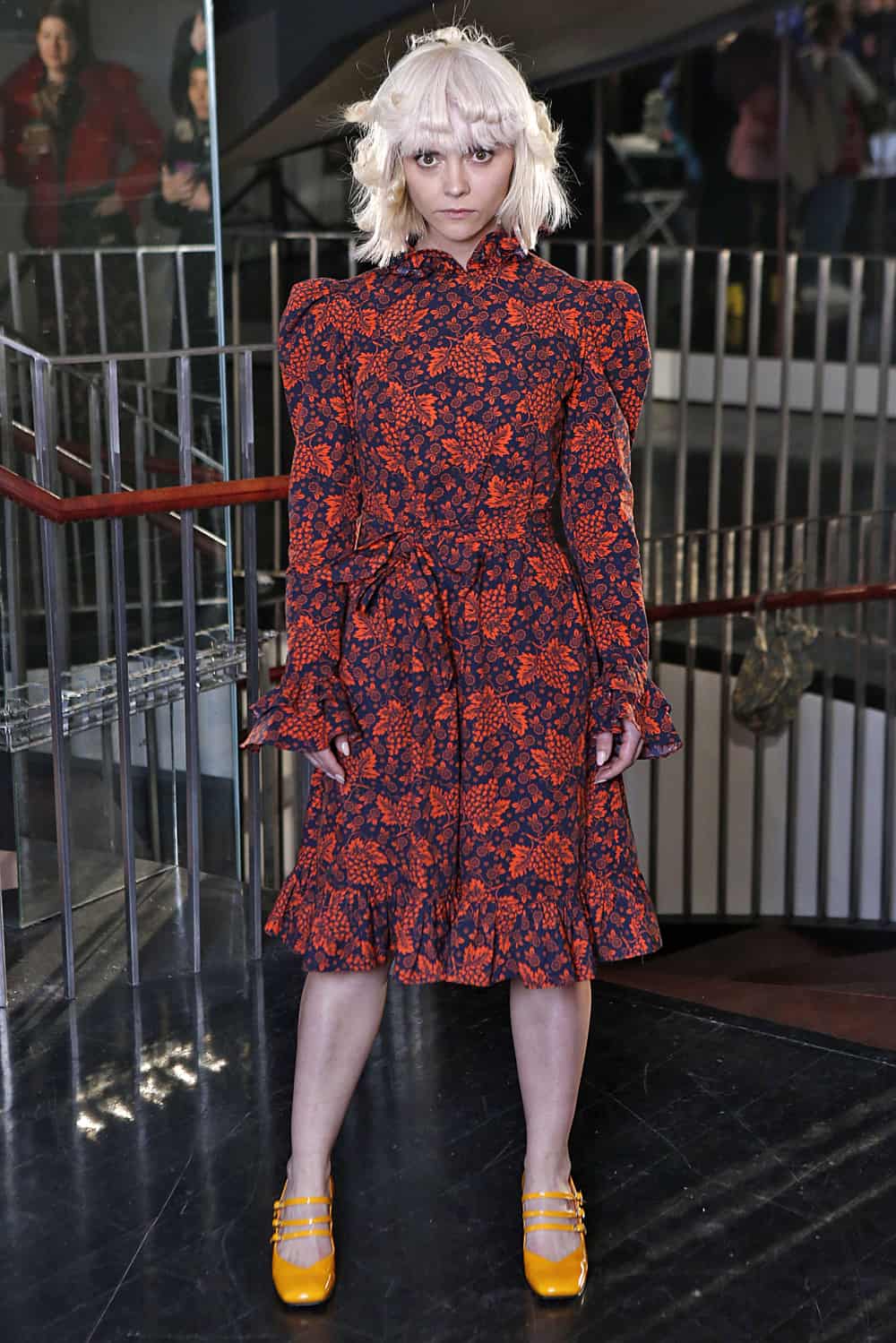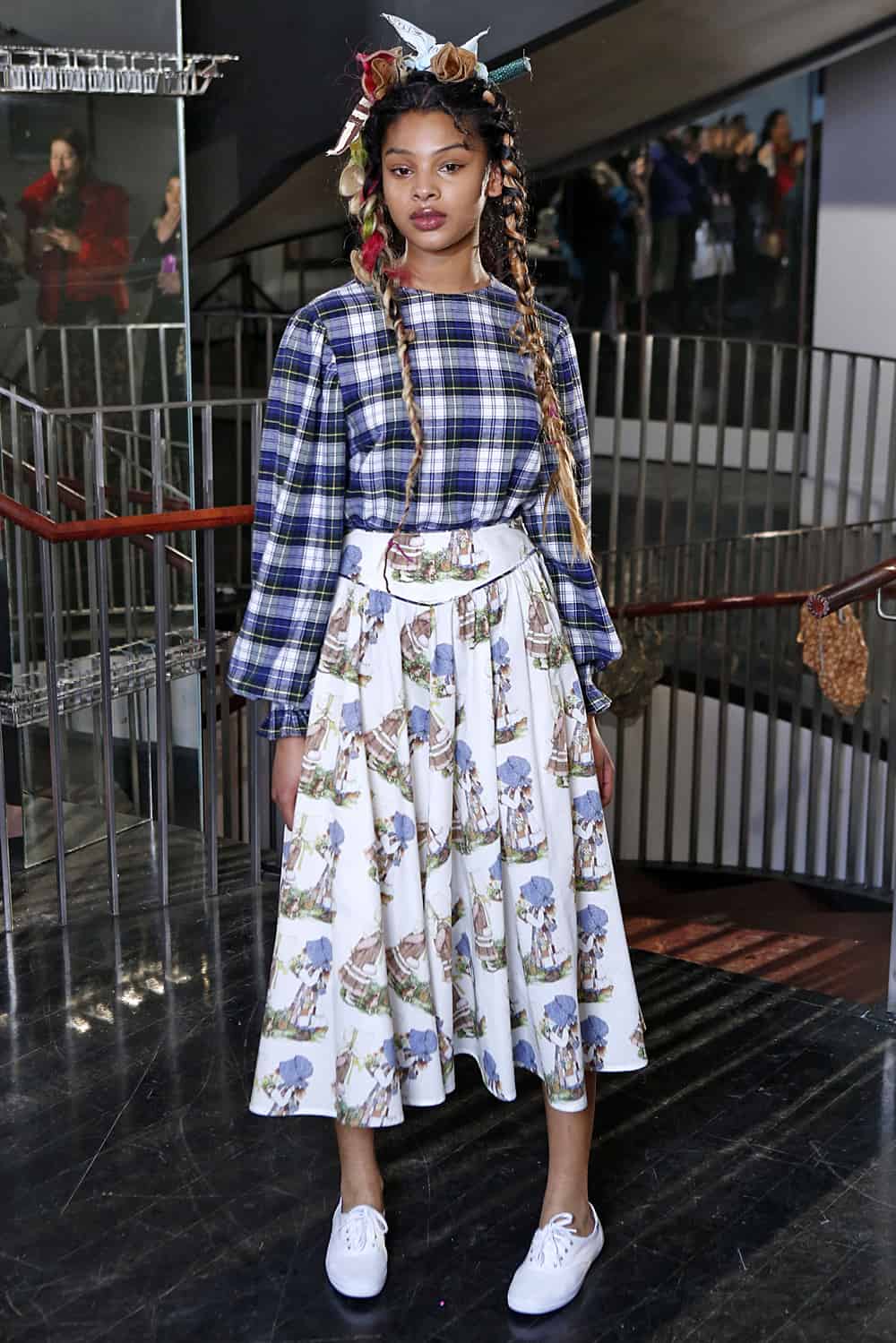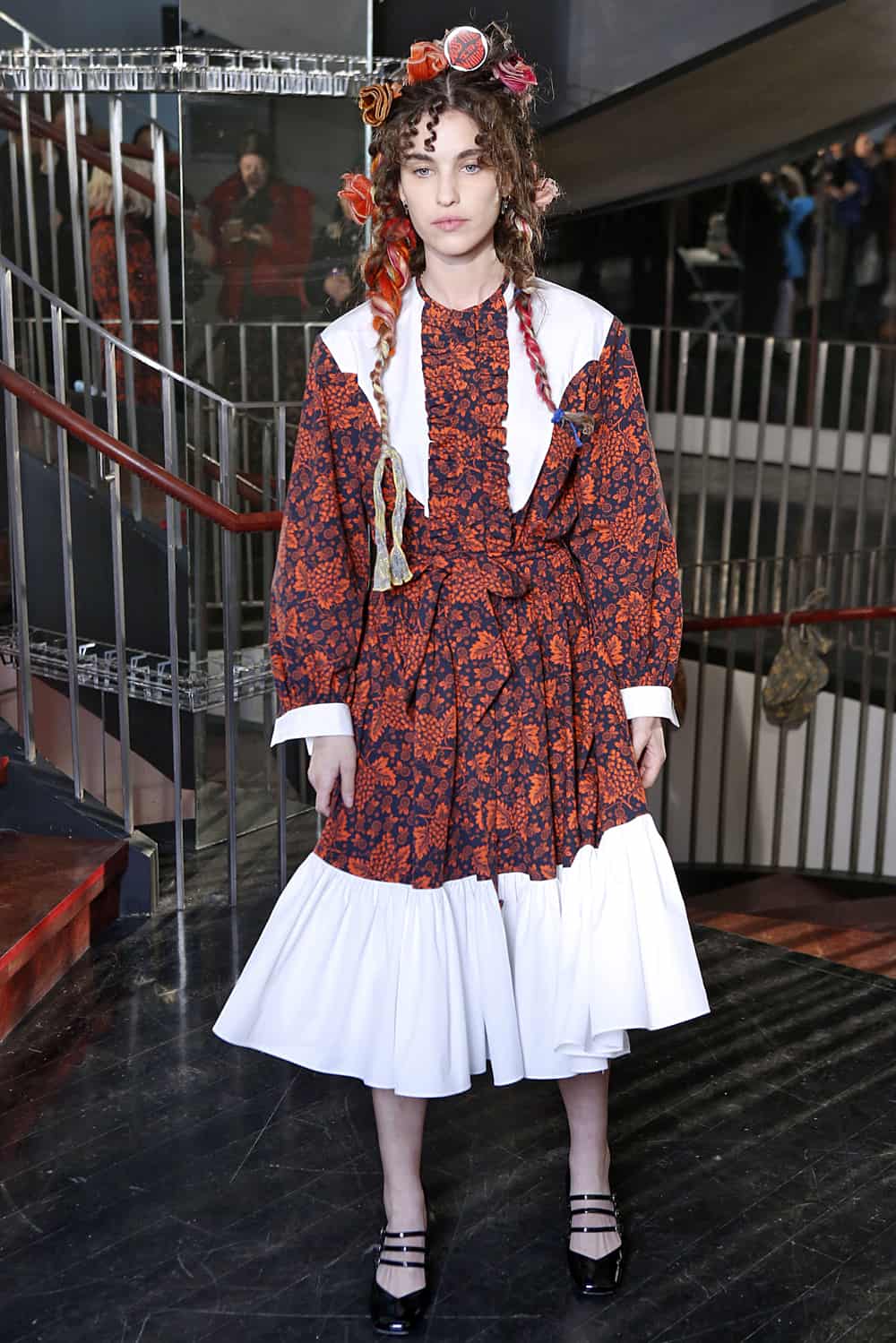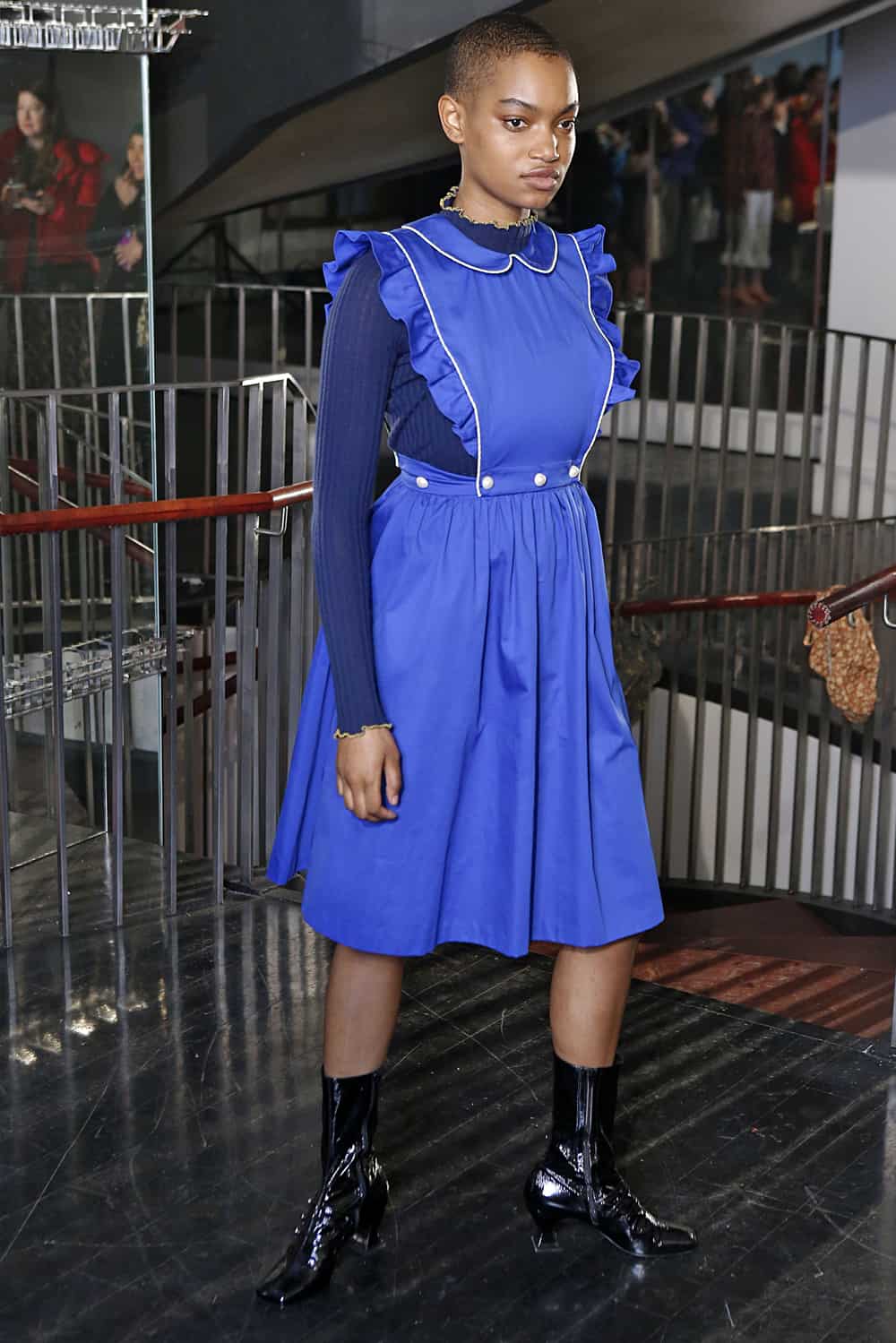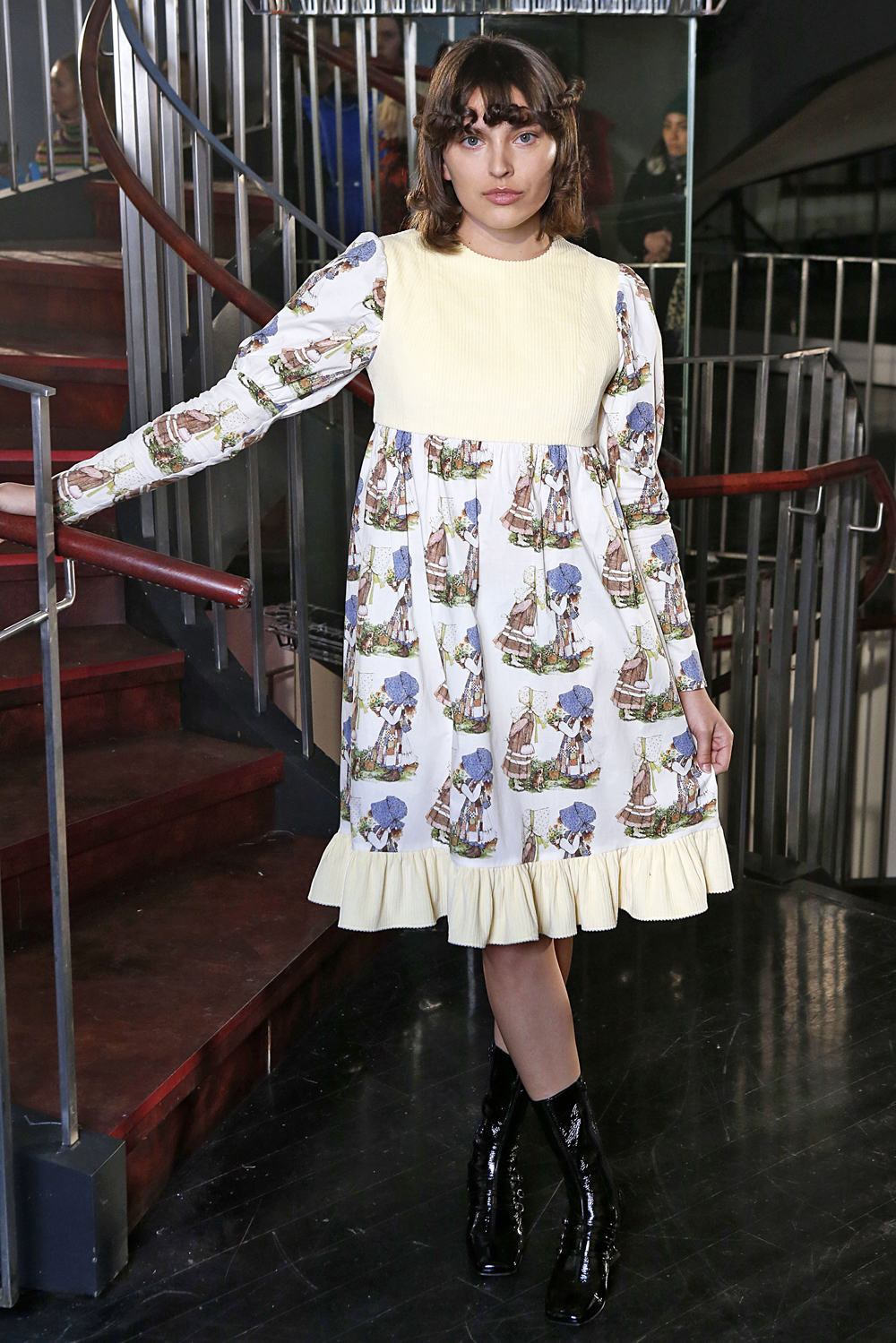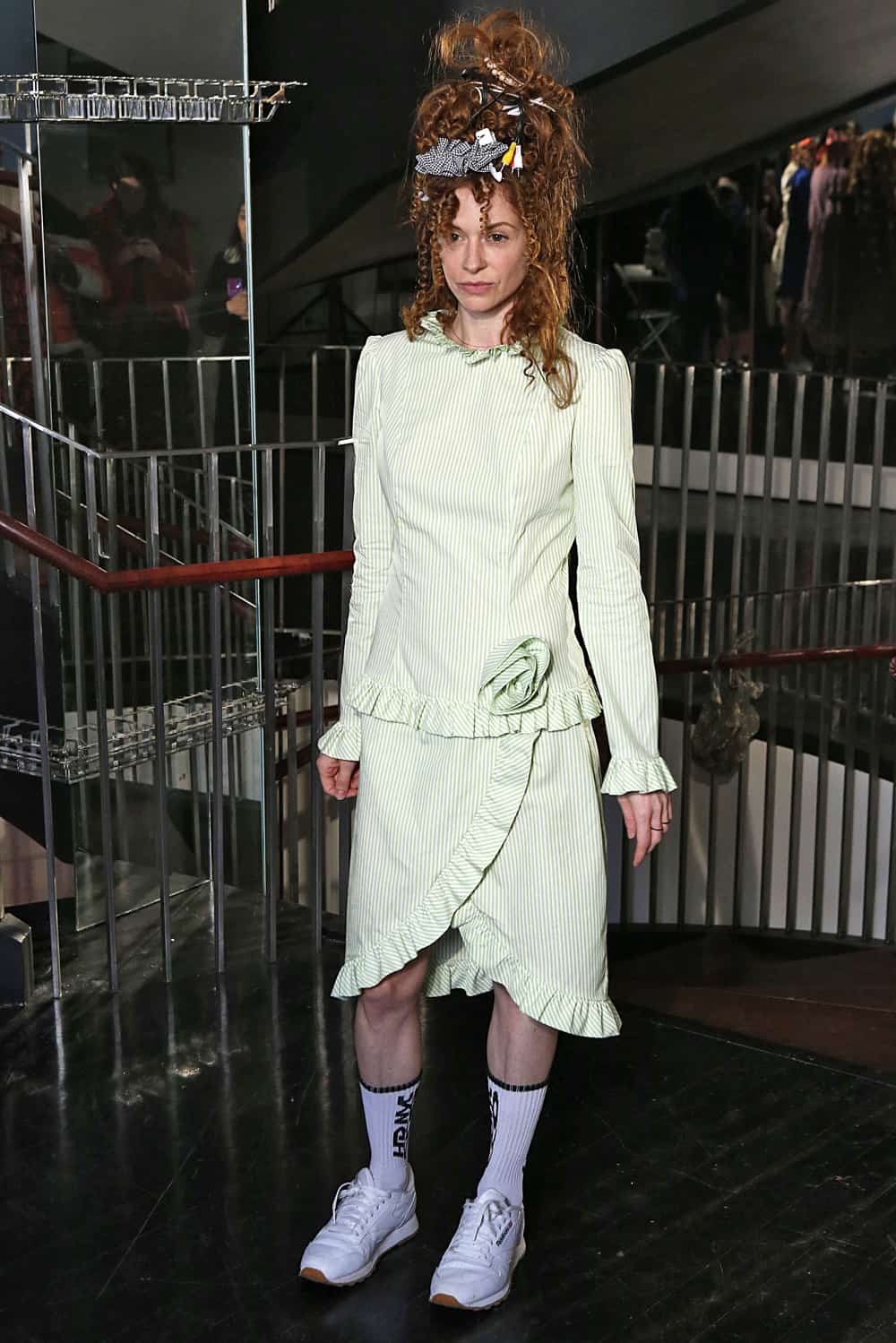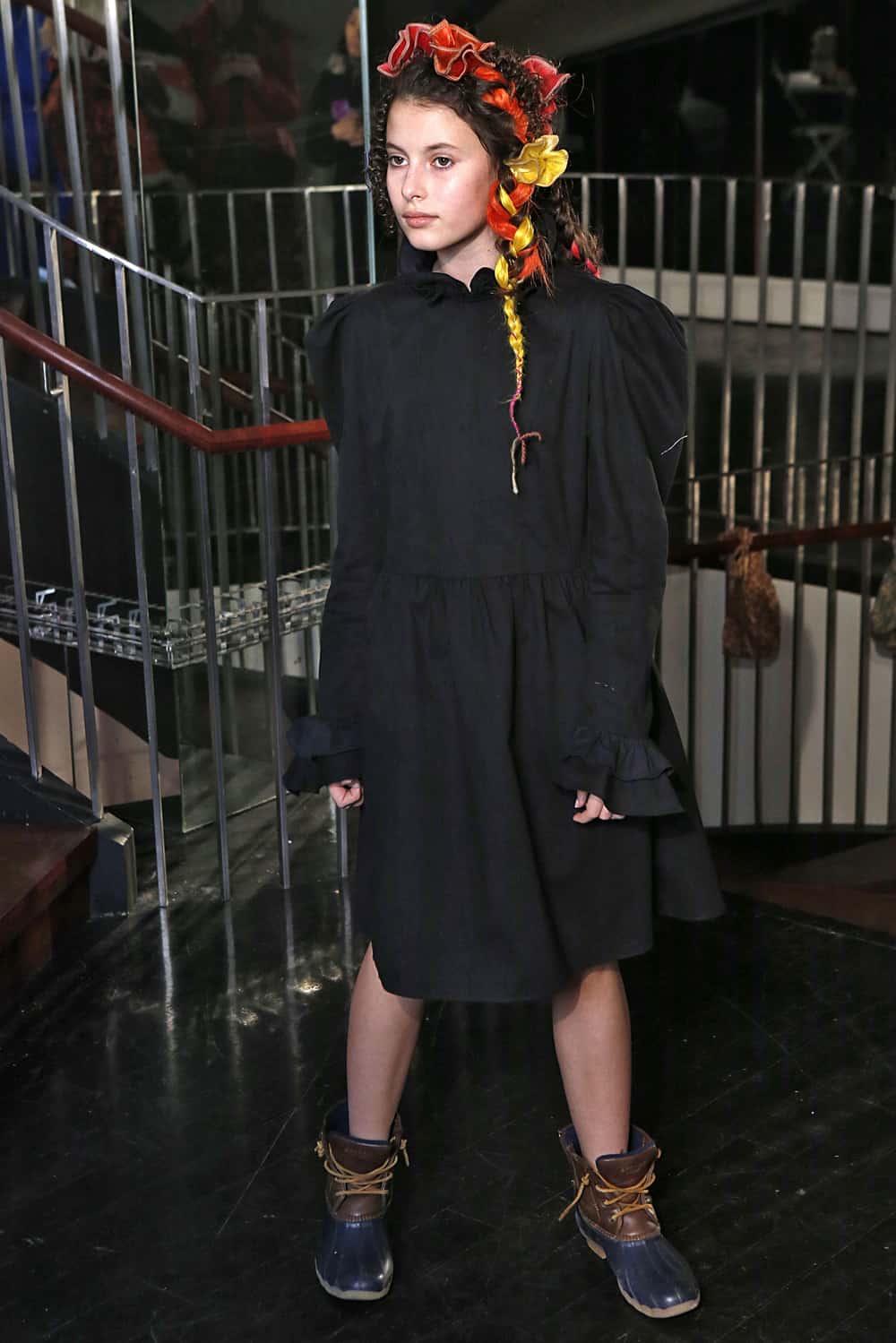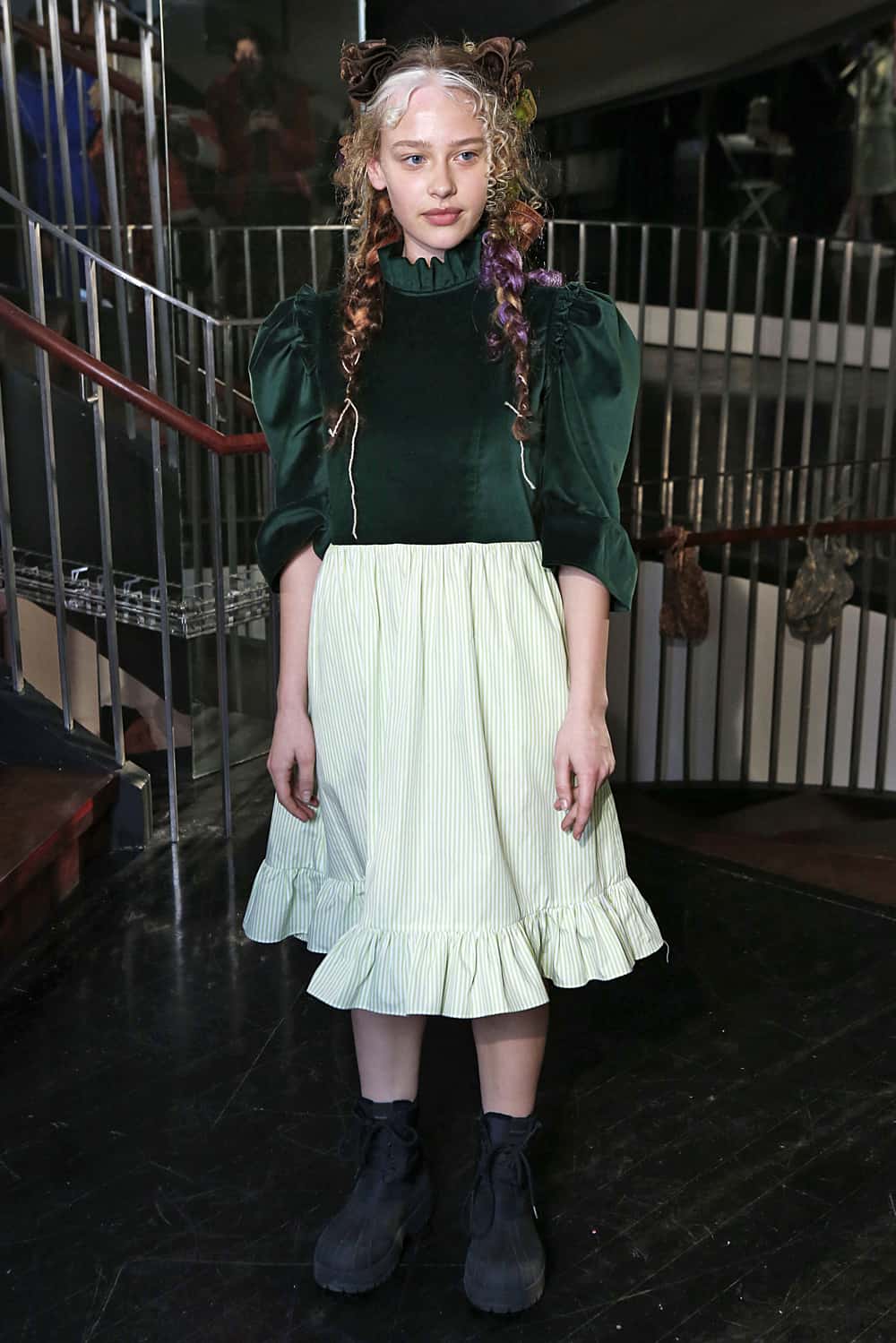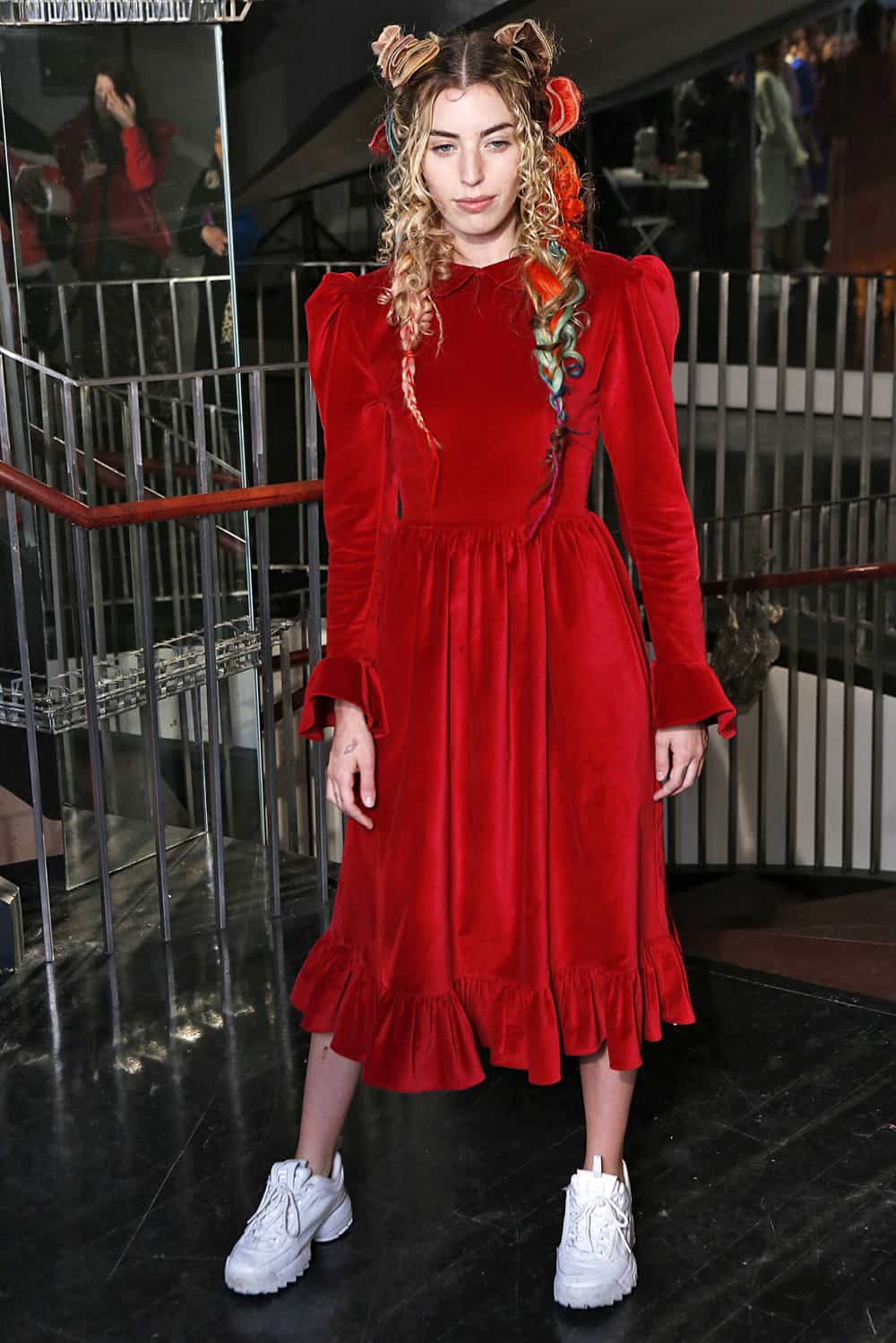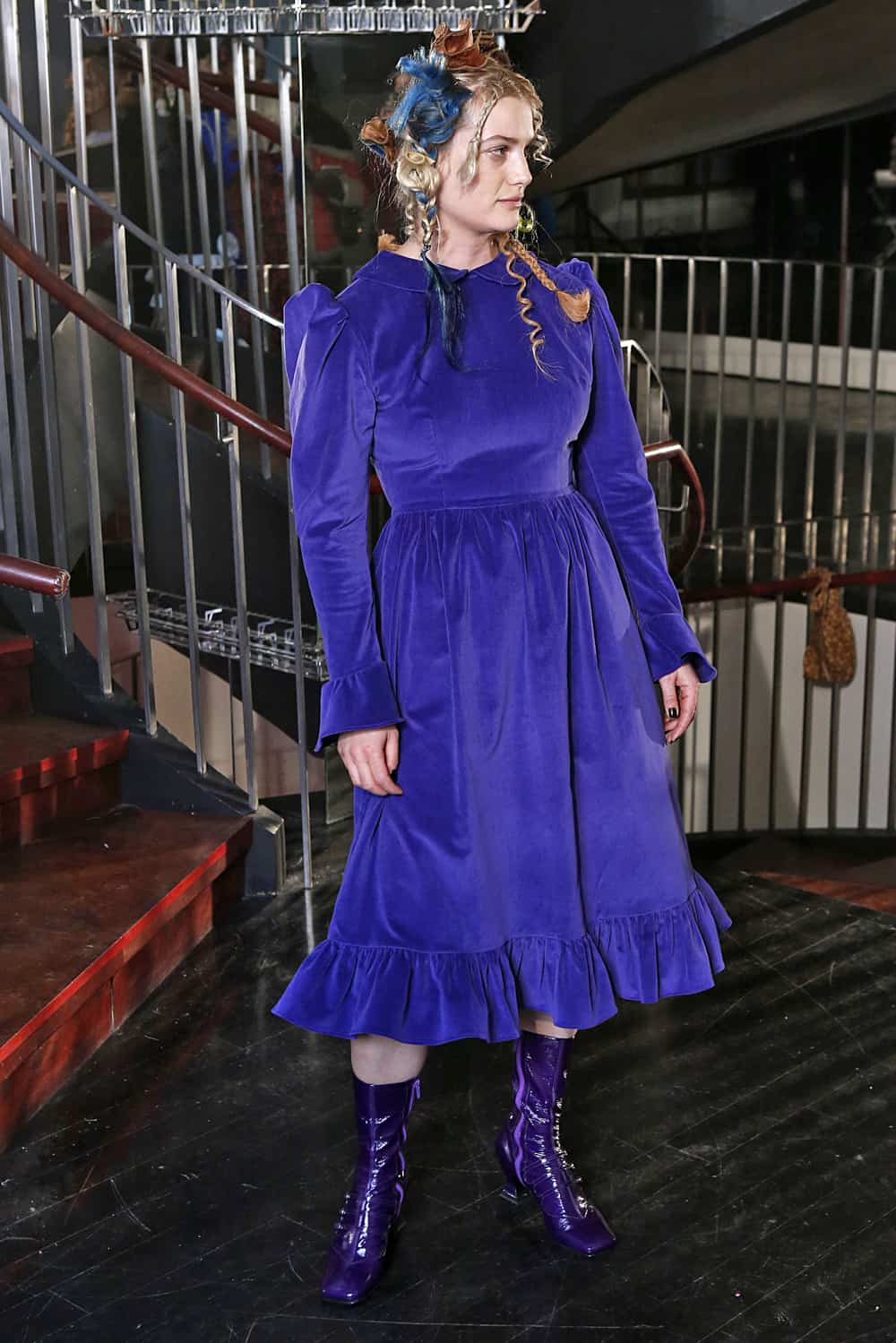Batsheva Hay might have held one of the best shows of the week. If the live band dressed in Hay’s Spring collection wasn’t a tip-off that something special was about to happen, the dual presence of former Hole members Courney Love and Melissa Auf der Maur should have been. Under Auf der Maur’s watchful eye, models approached a microphone to read isolated lyrics from Hole songs; a spoken word performance. Fittingingly the show started with the doll-like Christina Ricci reading the opening lines of “Doll Parts.” Later, singer/actress Alison Sudol, wearing Hay’s trademark dress style in purple velvet, sang the opening of “Violet.”

Alison Sudol reciting “Violet” (firstVIEW)
Love, seated on a couch with Hay at her side and Karen Elson behind her, recorded it all on her phone. Because what else do you do when your work is such a central part of a fashion show, if not put it on Instagram?
View this post on Instagram
From the zine-like (hand-written, collaged, and photocopied) quality of her show notes, to the live seamstresses sewing at the presentation — their machines were integrated into the cacophony of sound — Hay’s show was meant as a ode to the hand-made; a tribute to craft, and the work of women. Anyone looking for something radically new in the collection won’t find it, but that’s beyond the point. In an era in which we demand constant change — be it from designers, image makers, or artists — having an actual connection to our belongings is something of a novel idea. The reinterpreted nostalgia from the collection, and, to a certain degree, Love’s music, is a reminder that falling in love with one thing (even a dress) is far more enjoyable than being entertained by many.
- Batsheva Fall 2019 (firstVIEW)
- Batsheva Fall 2019 (firstVIEW)
- Batsheva Fall 2019 (firstVIEW)
- Batsheva Fall 2019 (firstVIEW)
- Batsheva Fall 2019 (firstVIEW)
- Batsheva Fall 2019 (firstVIEW)
The presentation ended with Esther McGreggor, clad in a wedding dress covered in red marker musings, singing the end of “Miss World.” Giving it her all, one couldn’t help but be charmed by the show. It was perfect.

The finale performance by Esther McGreggor
We caught up with Hay at her show to find out more about her collection and how the unique performance came together.
I have to ask, were you a big fan of Hole in the ’90s?
Yeah, for sure! So was my mom. It was a big part of my growing up and a big part of my adolescence. As I was designing clothes, I was going back to that. To be able to have this actually as part of the performance and everything was the ultimate “tying it all together” kind of thing.
How did the performance come together?
It happened out of sheer luck because we had these sewing machines set up, and we wanted to make music out of them. We decided to reach out to Melissa [Auf der Maur], who actually my husband knows. We’ve known her, and she does all this experimental music. So, we thought to bring her in, and then it was like a weird Instagram miracle that I turned on my Instagram and Courtney was following me, writing to me, and I just asked her to be a part of it. Then it kind of brought the whole team together under that idea of bringing it back to them — kind of being the inspiration for all of the women who come out as the whole spawn.
- Batsheva Fall 2019 (firstVIEW)
- Batsheva Fall 2019 (firstVIEW)
- Batsheva Fall 2019 (firstVIEW)
- Batsheva Fall 2019 (firstVIEW)
- Batsheva Fall 2019 (firstVIEW)
- Batsheva Fall 2019 (firstVIEW)
Tell me about the collection!
Basically it’s my “Salvation Army pull.” I grew up in Queens, and I would go to this amazing Salvation Army. Back then the Salvation Army was really amazing. You’d find real vintage gems, whereas now you find H&M. [This collection was] what I would pull in that mess of used things. Of course, in my adolescence there was a lot of flannel and plaid, so I included that. Also the old prints would be super kitschy because they were really from the ’70s. I used all these Holly Hobbie prints that reminded me of something you would find, the gem that you would pull out.
I had some Russian textiles I developed this season that also were the kind of thing that my eye would be attracted to, like the colorful purples or great prints. So, I took all of those kind of things I would find in a bin or on a round of scavenging and piece them all together in my shapes and my updated way. We made Victorian booties and Mary Janes this season to also be that version of that shoe you’d find in the corner of the vintage shop that was maybe too small for me.
- Batsheva Fall 2019 (firstVIEW)
- Batsheva Fall 2019 (firstVIEW)
- Batsheva Fall 2019 (firstVIEW)
- Batsheva Fall 2019 (firstVIEW)
- Batsheva Fall 2019 (firstVIEW)
- Batsheva Fall 2019 (firstVIEW)
How do you toe the line between staying true to what you’re known for, but pushing yourself to evolve?
I’m always doing the same shape. You’ll see that there’s always the same basic shape. It’s always there in a different fabric, and then I do it in basic ways, in strange ways, in new fabrics, and then I’m just adding new bits all the way. I added some knits and some shoes and just developing as the theme takes me. With the Holly Hobbie stuff, I wanted to do more pinafores, apron dresses, the flannel — I wanted to do something that was more of a comfy shirt. I have to say I am the type of designer… I’m not like John Galliano. I work on instincts a lot. It keeps getting broader and deeper in my own way.
Why is “slow fashion” important to you?
Honestly it’s what got me excited about fashion. Like I said, I’m not a traditional fashion person, but I am obsessed and passionate and excited in my own way. It happened a little bit because I really experienced it this time when I started designing through really getting down with a seamstress and with a pattern maker and touching the fabrics that I was using and really being a part of that whole process. I think that makes the garment so much more meaningful, and it’s really true. It’s was made me want to continue doing it and what made each piece something I was so invested in.
- Batsheva Fall 2019 (firstVIEW)
- Batsheva Fall 2019 (firstVIEW)
- Batsheva Fall 2019 (firstVIEW)
- Batsheva Fall 2019 (firstVIEW)
- Batsheva Fall 2019 (firstVIEW)
- Batsheva Fall 2019 (firstVIEW)

Batsheva Fall 2019 (firstVIEW)
Subscribe to our newsletter and follow us on Facebook and Instagram to stay up to date on all the latest fashion news and juicy industry gossip.


